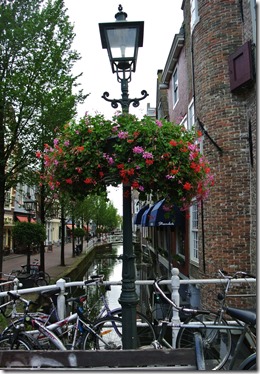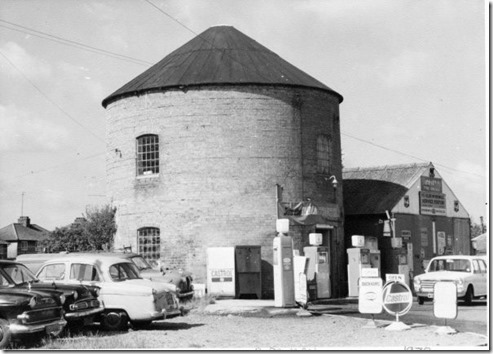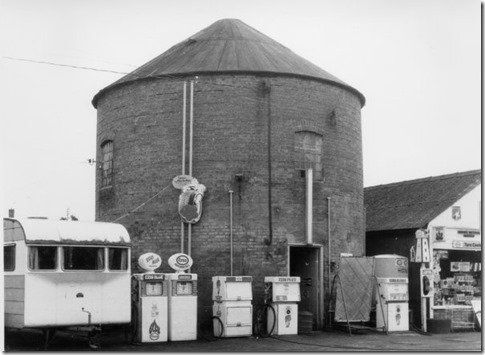https://eastward-ho.com/?p=2369
THIS WEEK – A Cake that really Celebrates Christmas…click at right for the recipe…
September took us almost due eastwards to Holland, in company with a group of 44 other mostly senior citizens swanning around Amsterdam, the Hague, Gouda and other places where works of great Dutch artists could be seen, as well as the houses in which they were born, lived, worked and passed on. I have always liked the country, so evidently the work of man in its incredible reclamation of land from the sea – the amazing use of space, the immense tidiness (except for a bit of litter in Amsterdam) and, of course, the ubiquitous bicycle, which comes in every form you can think of. There are cyclists everywhere. The Dutch people are charming, too, and you actually find them working in hotels, pubs and restaurants!
We travelled by Eurostar from St. Pancras to Brussels and had wondered why the tour operator recommended buying some food to take on to the train – the offerings in the Buffet Cars, which actually bore the name “Waitrose” on them were ghastly.
The food in Holland hadn’t changed a lot in the 25 years since we last were there; still fairly heavy, mostly fried with chips a-plenty. We remembered good Indonesian food, but this seems to have been diminished in availability and quantity. But it was the works of art we went for and we were not disappointed. The magnificent Rijksmuseum in Amsterdam, recently restored at as cost of 130 million Euros is a sight one ought to see at the very least once in one’s lifetime. It is only when you see great paintings “in the flesh” you realise the genius of their creators. Not only the huger canvases of artists like Rembrandt but very small ones, too, with tiny brush strokes and vivid detail.
Wandering around Delft, where we were based, a charming town with a delightful pedestrians-only old centre, the streets criss-crossed by canals, the street lamps adorned with flower baskets reminded us of home in dear, funny quiet old Saxmundham. And despite the glories of what we had seen, we were glad to be back and admire the work of our local painters, at work on the High Street shops.
In towns like Delft there are photo opportunities galore – pretty canal-side houses, shops and restaurants and many a flower bedecked street lamp. At dusk Delft is delightful to stroll around. Bikes are used by every age, from small boys and girls of four or five following their parents, to the very elderly. They are used to carry everything: students’ books, housewives’ shopping, babies, and very frequently as in the right hand picture, Man’s Best Friend.
GRINDINGS FROM THE MILL
Quite a lot of time at the moment is being spent piecing together the history of our home, Albion Mill, which is proving quite difficult. One bright light was shed on its recent years by the architects responsible for its conversion into a domestic premises – no less than 1172 photographs arrived on a CD-ROM, covering the period 2003 – 2006. Sorting these is keeping me quite busy. The big gap is in the period from its building in 1823 to its demise in 1907. Then there is its period as a petrol station and garage. Two good photos of this period, in the 1970s have come my way. Any others, and any information or anecdotes readers of Sax News may have will be warmly welcomed.
Can anyone put a date on either of these pictures? The left hand one seems to be a bit earlier than the other. Early 1970s? Any information will be gratefully received.
EATING OUT – if you can!
Sadly, at the moment one is dealing with closures rather than openings. To be expected, I suppose, but I was still surprised to see that 152 Restaurant in Aldeburgh’s High Street appears to have shut its doors. When visiting Suffolk over the years and since settling back here, we had had some very good meals there with our family and friends. The longer a place remains closed, the less likely it is to re-open and to pass what had been a good eating place with rooms above looking increasingly forlorn is miserable. I am talking of The Bell at Saxundham. One waits in hope for news of The Bell, perhaps in vain – who knows?
On a happier note, the 2014 Michelin Guide top 500 have been announced, and it’s good to see the Lighhouse at Aldeburgh is included. I think The Regatta ought to be there, too. A Daily Telegraph feature lists the “500 Best Restaurants” in the 2014 Michelin, from which I see just sixteen are in Suffolk, Norfolk and Essex. I think this is probably not a true reflection and I am preparing lists of good eating places, from by various guides, my own experience and that of friends, family and readers. All comments welcome at editor@eastward-ho.com Watch this space for news and reviews.








“LIKE WEBSTER’S DICTIONARY, WE’RE MOROCCO-BOUND” – A Story from the 1980s
A little while back I wrote about a short but unexciting experience in Algeria. Come to think of it, North Africa was never one of my happier hunting grounds in my working days, whereas I had some most interesting and occasionally lucrative assignments in the Eastern Mediterranean and the Arabian Gulf. One job in Morocco, though, deserves a book to itself… and it was a book, or rather TWO very large books that first introduced me to the country. Esoterically titled “Traditional Islamic Craft in Moroccan Architecture”, they sounded much more dry and specialist than they really were. They were the work of a French “Mr Fixit” who had fitted himself out as an architect/adviser-cum-supplier to King Hassan II of Morocco; an amazing man named André Paccard – look him up on Google, it’s worth it!
Whatever H.M. the King wanted, Paccard supplied it – whether it was fine French foods, machinery, household furniture and furnishings, jewelry or, in one case, 24 purpose-built villas for VIP foreign visitors invited for a royal celebration. But his jewel in the crown, so to speak, was to be two de luxe books about the mosques of the country. They would be a tribute and “thank you” to the King for his patronage. To do this he was facilitated to travel all over Morocco, photographing mosques old and new, grand and tiny, city-based and rural. But they provided much more than architectural and background photography and information; they recorded and graphically demonstrated the traditional Moroccan crafts that seemed doomed to die out, forgotten and unrecorded – stone work, tiles decorative and constructional, wood crafts of many kinds, pottery, glass and glassware, calligraphy and illuminated scroll-work – indeed every aspect of traditional Moroccan arts and crafts.
The pictures were stunning and, having been royally sponsored it was good business for Monsieur André Paccard, the author/publisher.
The two beautiful volumes, each of 500 pages, were originally published in 1980. A few copies may be had from various international booksellers at prices ranging from US$525 to $1,500. I am rather sorry I sold my set when we moved from England to Cyprus in 1991 for $200!
André Paccard had some years of success as a royal servant – eventually, for various reasons (over-reaching himself, perhaps; usurped in his work by some jealous employees, certainly, he fell from favour. After losing most of his assets, he died in the South of France in 1996, an embittered alcoholic. When his business was liquidated, I was left with several hundred copies of his master work. His French business associates didn’t want to know about these, so I was able to sell them off, slowly over about three years, to schools, universities, libraries and other institutions. Ultimately it became a “nice little earner”.
My second time in Morocco was on behalf of an American multi-national. I was there four days – and it rained the whole time. What I was able to see through the down-pours suggested to me that this was, is, a lovely country. Despite the torrential rain, we ate well in some of the best restaurants in Marrakech. The food was stylish – French, African and Arab influenced. It has some interesting recipes of its own, of which these are a couple, adapted from a delightful and practical small paperback, the cover of which is shown below.
Some new and second-hand copies are available from Amazon. If you are exploring regional cookery and want a very good starter volume with a varied range of recipes and ideas, it is well worth buying. Brand new tagines in which to make lovely North African “casseroles” are widely available, in many stores and on-line.
RECIPES
Chicken with Prunes and Almonds (Poulet aux Pruneaux et aux Amandes)
The French absorbed a number of dishes from the Moroccan cuisine into their repertoire, but oven baked foods cooked in utensils called tagines (a contemporary Moroccan-made example of utterly traditional shape is pictured above) have not become a part of their cooking in the way that couscous has, probably because combining fruit with meat is something they do only rarely. However fruit can be an excellent complement to meat and I have a liking for the dishes called tagines, like this one, which bring the sweetness and soft texture of fruit together with meat.
Preparation: 20 minutes. Cooking: 1½ hours
CHICKEN TAGINE – Ingredients for 4 Servings
1 chicken weighing about 1½kg /3 Ib
2 large onions, peeled and finely sliced
4 or 5 tbsp ground almonds (* See Note)
3 tbsp olive oil
20 prunes, pitted and soaked for 2 hours 1 tbsp mild paprika
Salt Pepper
1. First of all, soak the prunes in cold water for a couple of hours before you begin
to prepare the rest of the dish.
2. Rinse the chicken, cut it into small pieces and set aside.
3. Brown the onions, which should be very finely sliced, in a frying pan and then add the chicken pieces.
4. Once the chicken is tender, transfer it and the onions to a tagine or casserole, add the prunes, salt, pepper, paprika, the ground almonds and enough of the water in which you soaked the prunes to cover all the ingredients.
5. Stir well, then cover the pot and allow the stew to simmer over a low heat for one hour.
Serve in the tagine.
Note: For the best taste use fresh Cyprus almonds, peeled. Pat them dry and then whizz them in your food processor until they are finely chopped. Make them creamier if you wish by blending longer, but I prefer them with just a little “bite”.
Chicken with Lemon and Olives (Poulet au Citron et aux Olives)
Preparation: 20 minutes Cooking: 1 hour
Ingredients for 4 Servings
1 chicken weighing 1½kg/3lb
3 preserved lemons, cut into thin slices (see Note)
3 tbsp vegetable oil !
1 onion, finely chopped
3 cloves of garlic
200g/7oz purple olives, pitted
A thread of saffron (or half tsp of saffron powder)
A bunch of coriander (or parsley, if you don’t like coriander)
Salt and pepper
Method
1. Cut the chicken into pieces, brown them in oil in a large pan and put to one side.
2. Add the onion, garlic, saffron, salt and pepper to the same pan, stirring over a medium heat for 5 minutes before returning the chicken pieces to the pan together with enough water to cover all the ingredients.
3. Continue cooking, covered, until the chicken is tender, which should take about 45 minutes.
4. While the chicken is cooking, blanche the olives in boiling water for 5 minutes and, when the chicken has cooked for about 30minutes, add them and the slices of preserved lemon to the sauce.
5. Scatter over the chopped coriander just before serving.
PRESERVED LEMONS – Making ‘em and using ‘em
Preserved Lemons can be found in some Deli counters. But they are simple to do yourself, but remember you need to make them a couple of weeks before you intend to use them.
Preserved Lemons Recipe
1. Select firm, fresh, unwaxed lemons.
2. Trim the nubs off both ends of each lemon.
3. Cut the lemon as if you are going to cut it into four pieces, but don’t complete the cut.
4. Put a teaspoon of salt in the bottom of a half-litre/pint-sized jar.
5. Put another teaspoon of salt into the quartered lemon.
6. Push the lemon into the jar, open end down, and push hard to squash it a bit so as to release its juices.
7. Put a teaspoon of salt over the top of the lemon.
8. Repeat the process, putting a teaspoon of salt inside the second lemon, and then squash it down hard on top of the first lemon.
9. Add another teaspoon of salt on top of the second lemon, and repeat the process for the third and final lemon. Add a teaspoon of salt on the very top. The jar should be halfway full of lemon juice from having compressed the lemons. If needed, squeeze some extra lemon juice into the jar to bring it to the halfway point. And don’t waste that lemon – cut it up and stuff it into the jar.
10.Now pour some water that’s been boiled and cooled (sterile) into the jar to fill it up the rest of the way. Repeat this process for however many jars you wish to make.
11.After you add the water, screw on the lid and let the jar sit at room temperature for 3 days, giving it a shake and turn it upside-down/right-side up a few times a day.
12.After 3 days place the jar in the refrigerator and let it sit for at least 3 weeks before using. Keep the jar in the refrigerator.
NOTE: Whatever dish you use them in, discard the pulp (it’s the peel that is used) and thoroughly wash the peel to remove excess salt.